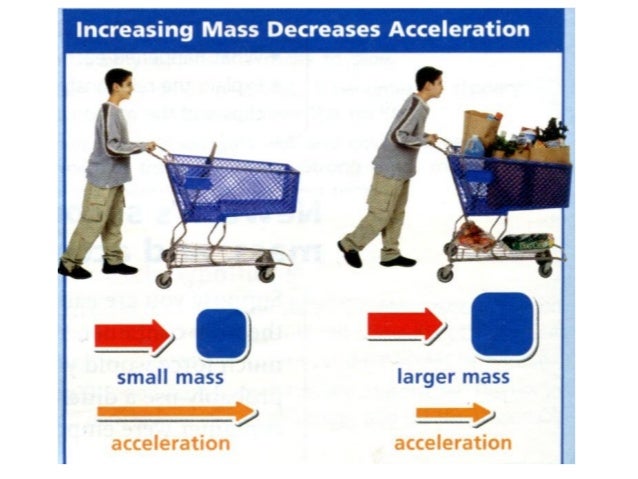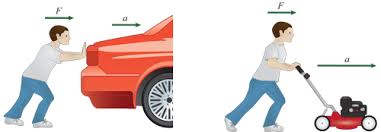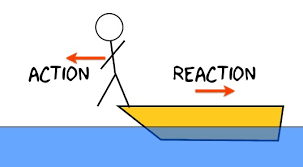State Newton's First Law of Motion. (You need to memorize each law).
An object at rest stays at rest and an object in motion stays moving at a constant velocity until acted upon by an unbalanced force.
State Newton's Second Law of Motion.
Force = Mass x Acceleration
State Newton's Third Law of Motion.
Every action has an equal and opposite reaction.
What is a force?
A push or a pull.
Define Friction.
Friction is the force that opposes the motion of an object. Everything in motion eventually stops because of friction (if there is no force applied).
 What law was this activity an example of?
What law was this activity an example of?
Newton's First Law of Motion, also known as the Law of Inertia. An object at rest stays at rest and an object in motion stays moving at a constant velocity until acted upon by an unbalanced force.

Newton's Second Law of Motion.
Force = mass x acceleration
With the same force (equal size red arrows) the acceleration on the cart will be greater (bigger yellow arrow) because its mass is smaller (common sense visual and blue box). Think bowling!
Newton's Third Law. Every action has an equal and opposite reaction. Forces always act in pairs.
What is the sum of all the forces acting on an object called?
Net force
What are the four types of friction?
sliding, rolling, fluid, and static

Newton's Second Law of Motion.
Force = mass x acceleration
With the same force (equal size arrows) the acceleration on the lawn mower will be greater (bigger arrow) because its mass is smaller (common sense). Think bowling!

Newton's Third Law. Every action has an equal and opposite reaction. Forces always act in pairs. The action would be your finger pushing the wall and the reaction would be the wall pushing back on your finger.
Newton's first law, or the law of inertia. An object at rest stays at rest and an object in motion stays moving at a constant velocity until acted upon by an unbalanced force.
What type of force causes motion?
Which has more friction, the grass or the hallway?
The grass has more friction. If I were to roll a ball on the grass and in the hallway, it would go slower and stop sooner on the grass.

Newton's Third Law. Every action has an equal and opposite reaction. Forces always act in pairs.
This soccer ball will not move until someone kicks it.
Newton's first law, or the law of inertia. An object at rest stays at rest and an object in motion stays moving at a constant velocity until acted upon by an unbalanced force.
 Calculate the net force. Include an arrow and unit.
Calculate the net force. Include an arrow and unit.
50 N to the left.
Since the arrows are pointing in opposite directions, I subtract. If they were in the same direction, I would add.
What kind of force causes no motion? Give an example.
A balanced force. An example would be the pen on my desk.
Is there gravity in space?
 What law? State it. Add in some fake numbers and arrows with a unit (N).
What law? State it. Add in some fake numbers and arrows with a unit (N).
Newton's Second Law of Motion. Force = mass x acceleration
I would make two arrows pointing away from each other and the one pointing to the right should have a bigger number. Both numbers should have N for a unit.
You are riding in a vehicle with a coffee cup on the dashboard while traveling 30 km/h. The vehicle makes a sudden stop to avoid hitting the car that has stopped in front of it. What would happen to the coffee cup?
WHY?
The coffee cup would move forward. Newton's first law states: An object at rest stays at rest and an object in motion stays moving at a constant velocity until acted upon by an unbalanced force.The coffee cup was still traveling at 30 km/h. Think of the penny on the car activity.
A ball of rubber bands has a mass of 10 kg. If you roll the ball with an acceleration of 2 m/s/s how much force did you use to roll the ball?
Newton's second law of motion tells us that force = mass x acceleration. So, plug the numbers in:
force = 10 kg x 2 m/s/s
force = 10 x 2= 20 N
How much net force is required to accelerate a 2000 kg car at 3.0 m/s/s?
F=ma
f=2000 * 3
f=6000 N
Is there friction in space?
NOPE! Space is a vacuum. Gravity and inertia keep the planets revolving around stars and the moons revolving around planets. It's our next unit!!!